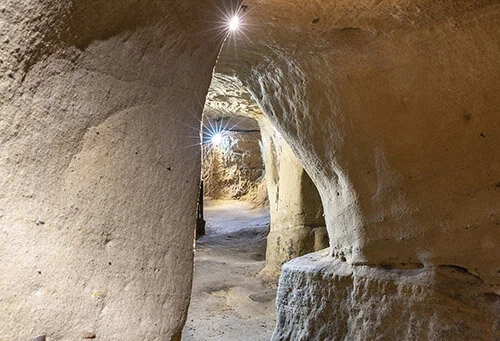Week 15: Leicester to Nottingham
I’m writing today from a very different place than I found myself in this time last week.
Last week at this time, the fire had expanded by more than 40,000 acres in one week, due to warm weather, high winds, and very dry conditions.
Most of this week was more of the same: days of raining ash, high winds, Red Flag warnings, evacuations… We even had a rare “smoke-nado” this week!
Truly, the firefighters have not had an easy time.
Somewhere on the Cameron Peak Fire, using a road to contain one edge of the fire, October 18.
Somewhere on the Cameron Peak Fire, a bulldozer building a containment line, October 20.
Have you ever heard of a “smoke-nado?” Me neither… but apparently Cameron Peak produced one this past week.
Looking down the street from our house on Thursday, October 22. I took this photo at about 2pm - what should’ve been broad daylight - but it was so dark that passing cars were using their headlights, and the photosensitive streetlights that usually pop on at sunset all came on.
Firefighters from all across the country are among the 1,864 people currently assigned to put out the Cameron Peak Fire… including a contingent from Puerto Rico!
This week the fire expanded again, by 5,410 acres. It now sits at 208,663 acres, and 61% containment. Fortunately, overnight the temperatures dropped, and we woke up to SNOW!
Cameron Peak Fire’s Incident Command just outside Loveland, morning of October 25.
As you all know, from following along with me over the past few weeks, we’ve had snow on the fire before; back in September parts of the fire were hit with more than 16 inches! But fires today burn SO hot that they can often evaporate snow before it even lands… so despite that wonderful precipitation, the wildfire burned on.
For now, officials aren’t predicting this storm will end the wildfire, but a snowstorm certainly beats the Red Flag conditions we’ve had in recent weeks! Hoping the snow helps firefighters get a handle on Cameron Peak, let’s get back to rainy Great Britain.
We’d just made it to Leicester at the end of last week, so let’s start there…
Portrait of Richard III by an unknown artist. National Portrait Gallery, London.
I love a good ghost story, and this week my friend Cassandra shared a really great one with me. It starts back in 1485, during the Wars of the Roses.
On August 22, 1485, the Houses of York and Lancaster were facing off just southwest of Leicester, at a place known as Bosworth Field. By the end of the day, the Lancastrians - led by Henry Tudor, Earl of Richmond - had won. King Richard III (who by virtue of this lost battle became the last monarch of the House of York) was killed during the battle (making him also the last English monarch to be killed in combat).
Because of the monumental shift this battle represented — a new king, a new dynasty coming to power — it was important to prove decisively that Richard was dead. So Henry had Richard’s body taken into Leicester, where it lay on display for a few days, after which it was buried in the graveyard of Greyfriars Church, nearby.
Years went by. Eventually the church was dissolved and sold by King Henry VIII. The land became someone’s residence, then a bureaucratic building, then a parking lot… and over all those years, Richard’s body lay underneath, forgotten in an unmarked grave.
Fast-forward to 1884, when Leicester gets its own professional football club — that’s “soccer,” American friends — known as the Foxes. And while the team had some good seasons and some bad seasons, at no time in 130+ years did the Foxes win a top division title. As Leicester-born football announcer Arlo White described it, early in 2016, “They have never won a top division title in their entire 132-year history. You know, Chicago Cubs fans think they've got it bad [having not won the World Series in 108 years]. You should try being a Foxies fan all these years."
More time passes, and in September 2012, human remains are uncovered as the parking lot is being dug up to make space for a new building. The physical characteristics of the body, as well as DNA evidence, conclusively proves that the body is that of Richard III. This discovery led to Richard being feted in a very kingly way, at a March 2015 ceremony presided over by the Archbishop of Canterbury, then buried with great fanfare in a tomb within Leicester Cathedral.
Then a miracle happened.
At the time of Richard’s reburial, the Foxes were in last place. From then on, they went on a winning streak, taking first place. And in May 2016, the Foxes became the champions of the Premier League.
Photo by Michael Regan, Getty Images. Incidentally, the “King Power” on Leicester’s jerseys is a Thailand-based duty-free-shop company that sponsors the team, not a comment on the source of Leicester’s good luck.
So all that time, was the Ghost of Richard III cursing the Foxes? Stewing, offended at his ignoble, forgotten burial? Such that once the people of Leicester accorded him the honors he deserved, he would smile upon them again? We will never know… but that is how the story ended.
Oh, and as an aside, wouldn’t you know it: in 2016 the Cubs’ World Series drought also ended, as they topped the Cleveland Indians 4-3 to break their long losing streak. Who knew Richard was a Cubs fan?!
Moving north, we find ourselves in Nottingham, which many Americans will associate with tales about Robin Hood, his Merry Men, and the Sheriff of Nottingham. Those stories, which date back to at least the 14th century, make free reference to Nottingham and its environs.
But what I’d never heard about until this week is that Nottingham sits on a ridge of soft sandstone hills, and the River Leen and the River Trent have in places eroded all the topsoil, exposing soft crumbly rock that is easy to carve into. Now, more than 500 caves exist underneath Nottingham, and many of them are open for the public to visit.
Inside some of the caves that are open for tourists.
One of the many cave entrances in Nottingham. Photo by Elliott Brown.
Another great site to visit in Nottingham (and which has a whole cave tunnel network too) is Nottingham Castle… but as we pass through Nottingham, we’re not going inside to tour the castle. That’s because right now, Nottingham Castle is undergoing significant restoration work, both exterior and interior, that is expected to cost more than £30M.
The castle’s exterior will be restored and reinforced, and the castle grounds re-landscaped.
The castle’s interior will be renovated to better showcase its permanent art collection, as well as special exhibits about lacemaking (a key industry of Nottingham’s) and the region’s cultural legacy.
Nottingham Castle sits high upon a hill now known as “Castle Rock.” Like many of the castles we’ve visited on this virtual trek, it has had many incarnations over the years. It is believed that the first fortifications here were wooden, and date to 1068. By the reign of King Henry II in the mid-12th century, the fortifications had been redone in stone. These continued to be reworked and expanded over the next 300 years.
But by 1600, more modern artillery had begun to make the castle obsolete, and by the time of the Civil War, it was largely demolished, mostly to prevent anyone from taking it over and using it again. It mostly sat as a ruin until the mid-19th century, when King Edward VII had its grand hall renovated into an art museum. The upcoming series of major renovations seeks to offer a glimpse of all the various stages of Nottingham Castle’s incarnations. It sounds exciting, and I’m glad this preservation work is being prioritized.
Fancy a pint?
Unlike the Naylor brothers, who pledged to “abstain from all intoxicating drink” during their 1871 walk on this route, I’m not at all opposed to popping into interesting-looking pubs along the way. Here are a few along this stretch of the journey.
Wygston’s House, a historic pub in Leicester.
The oldest house still standing in Leicester is also one of its loveliest: Wygston’s House has gorgeous exposed beams, leaded-glass windows, and gleaming broad-planked floors. Built around 1490, it was a residence for many of the most prominent citizens of Leicester over the centuries.
In 1974, after some significant restoration work, the building became a clothing museum. And recently, it became a pub and restaurant.
And, excitingly, its menu offers a number of vegan options!
Nottingham’s Bell Inn
We’ll visit another very old pub as we arrive in Nottingham. At some point before 1271, friars established a guesthouse on the site now occupied by the Bell Inn. That building was reconstructed around 1420 to serve as a dining hall for the monks of the monastery on Beastmarket Hill. When Henry VIII dissolved the monasteries in 1539, it became a secular alehouse… which it remains to this day.
And as with so many buildings in Nottingham, there’s a complex web of tunnels and caves you can enter from within the Bell Inn. Come for the ale, stay for the spelunking adventures!
Ye Olde Trip to Jerusalem, one of the oldest pubs in England
And finally, another of the pubs angling for the title of “oldest in Britain” is Ye Olde Trip to Jerusalem, a pub that dates to around the time of the first Nottingham Castle, 1068. It touts its role in serving a refreshing beverage to crusaders headed to Jerusalem, and knights stopping by to enjoy a pint.
What isn’t disputed is that the site - positioned at the foot of Nottingham Castle, with caves that make up the perfect climate for brewing - has indeed served for centuries as a place where beer has been brewed. Apparently a tube carved in the rock could even be used to shout for more ale from within the castle, to the brewing house.
Sustenance for the Hungry Vegan
Salad with curry chickpeas, at Healthy Louisa Cafe, Leicester.
In Leicester, Healthy Louisa Cafe is an all-vegan restaurant founded by three friends who wanted to share “healthy, tasty food” with “easy recipes to follow.”
The food looks delicious AND beautiful… all those colors! And as many ingredients as possible are sourced locally, too, as the Louisa team wants to support the community.
So if you like the look of this salad with curry chickpeas, or any other menu item on their website, you can make it yourself!
Leicester’s Prana Cafe
No one goes home hungry from Cafe Roya, in Nottingham. Every photo I found of their dishes online shows beautiful vegetables nearly spilling over the edges of their serving platters.
This vegetarian restaurant, which offers lots of vegan options, attracts accolades online, even from people whose reviews begin “I’m a dedicated carnivore, but…”
They just celebrated ten years in business, and hopefully will continue for many more.
Tucked away in a historic building in Leicester, we find Prana Cafe, another 100% vegan cafe with a range of options, from smoothies to sandwiches to rice/quinoa bowls.
In addition to feeding the body, Prana seeks to nourish the soul and mind, offering events in house including yoga, meditation, poetry recitals, and screenings of documentaries.
Did I mention it also has a huge vegan bakery? The desserts are a marvel to behold, and I can only imagine how delicious they taste.
A feast at Cafe Roya, Nottingham


























